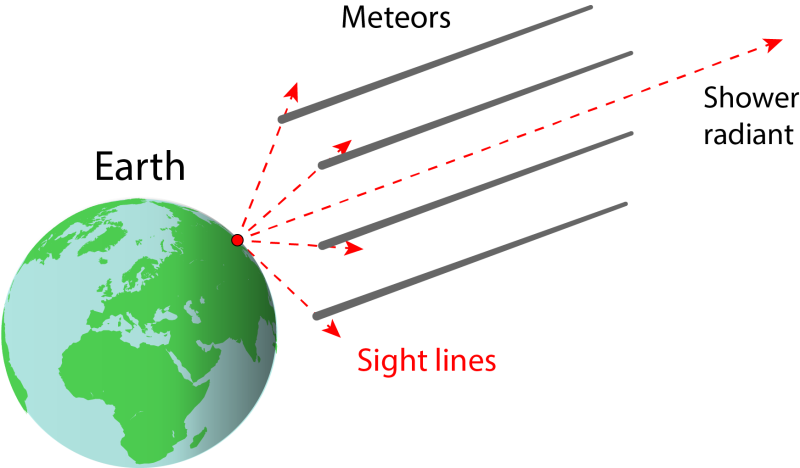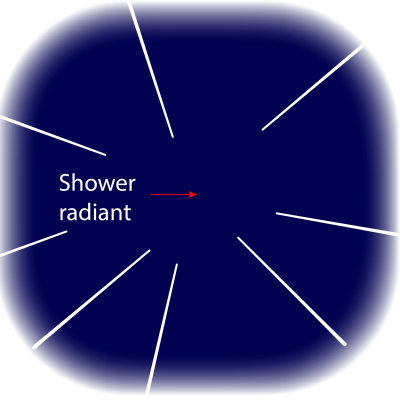2,231 days ago
Dominic Ford, Editor
From
the Meteor Showers
feed
Observers in Europe, the east coast of North America, South America and Africa may get a chance to see a rich storm of meteors over the night of November 21–22.
The α-Monocerotid shower, named after the constellation Monoceros, the celestial unicorn, is usually a very modest meteor shower which produces so few meteors that it is barely noticeable. Occasionally, however, it produces a dramatic storm of meteors – most recently in 1925, 1935, 1985 and 1995. At the peak of the 1985 storm it produced around 700 meteors/hour, and in 1995 around 400 meteors/hour.
Astronomers Esko Lyytinen of the Finnish Fireball Network and Peter Jenniskens of the SETI Institute have predicted that it may do so again this year. Their prediction is based on a model of the distribution of material within the debris stream which produces the meteor shower, which suggests the Earth may pass through a particularly dense pocket of material at around 04:50 UTC (GMT) on 22 November. If this is correct there might be an intense storm of meteors at that time, lasting around 15 minutes.
All such predictions are subject to a great deal of uncertainty, and the precise timing of the storm is particularly hard to estimate. The storm may come earlier or later, or not occur at all. Observers are being advised to start observing by 04.15 UTC, in case the storm should take place earlier than predicted.
If a storm occurs, the number of meteors which you will see depends on the altitude of the shower's radiant point in the sky as well as the rate of dust particles colliding with the Earth's atmosphere. If the radiant point is high in the sky, this means that your location on Earth is turned optimally to face the direction from which the meteors are coming. Conversely, if the radiant is low in the sky, your location appears on the limb of the Earth as seen from the direction of travel of the meteors, and the meteors will be more thinly spread over the Earth's surface.
The predicted timing of this year's storm is ideal for observers in Africa, where Monoceros will be almost overhead at the time, and South America, where it will be around 60° above the horizon. The storm will also be well placed for observers in Europe and on the east coast of North America, where Monoceros will be around 30–40° above the horizon.
Finding the unicorn
Although Monoceros is not itself a prominent constellation, it borders several much more recognisable constellations. These include Canis Major, home to the brightest star in the sky – Sirius – and Orion the Hunter. Seen from the northern hemisphere, you can find Monoceros just to the left of Orion.
Once you've found the radiant point, you've found the point from which the meteors will appear to radiate outwards. To see the most meteors, however, it is best not to look directly at the radiant itself, but rather at any dark patch of sky which is around 30–40° away from it. It is at around this distance from the radiant that the most meteors are likely to be be seen.
The origin of the shower
Meteor showers arise when the Earth passes through streams of debris left behind in the wake of comets and asteroids. Over time, the pieces of grit-like debris in these streams distribute themselves along the length of the parent object's orbit around the solar system.
Shooting stars are seen whenever one of these pieces of debris collides with the Earth's atmosphere, typically burning up at an altitude of around 70 to 100 km.
On certain days of the year the Earth's orbit passes through particularly dense streams, associated with comets or asteroids which have vented particularly large amounts of solid material to space, and this gives rise to an annual meteor shower. Such showers recur on an annual basis, whenever the Earth passes the particular point in its orbit where it crosses the particular stream of material.


The meteors that are associated with any particular meteor shower can be distinguished from others because their paths appear to radiate outwards from a common point on the sky, which points back in the direction from which their orbital motion brought them.
This is because the grit particles in any particular stream are travelling in almost exactly the same direction when they cross the Earth's orbit, owing to having very similar orbits to the parent object they came from. They strike the Earth from almost exactly the same direction, and at the same speed.
To see the most meteors, the best place to look is not directly at the radiant itself, but at any dark patch of sky which is around 30–40° away from it. It is at around this distance from the radiant that the most meteors will be seen.
By determining the position of this radiant point on the sky, it is possible to work out the orbit of the stream giving rise to any particular meteor shower. It is sometimes even be possible to identify the particular body responsible for creating the debris stream, if there is a known comet or asteroid with a very similar orbit.
The parent body responsible for creating the α-Monocerotid shower has been identified as comet C/1917 F1 (Mellish).
The radiant of the α-Monocerotid meteor shower is at around right ascension 07h40m, declination 1°N, as shown by the green circle on the planetarium above.
The sky on 22 Nov 2019
| The sky on 22 November 2019 | ||||||||||||||||||||||||||||||||||
|
16% 25 days old |
All times shown in PST.
|
|||||||||||||||||||||||||||||||||
Source
The position of the radiant of this shower, and its predicted hourly rate, were taken from International Meteor Organisation's List of Meteor Showers.
Image credit
Image courtesy of Stellarium


